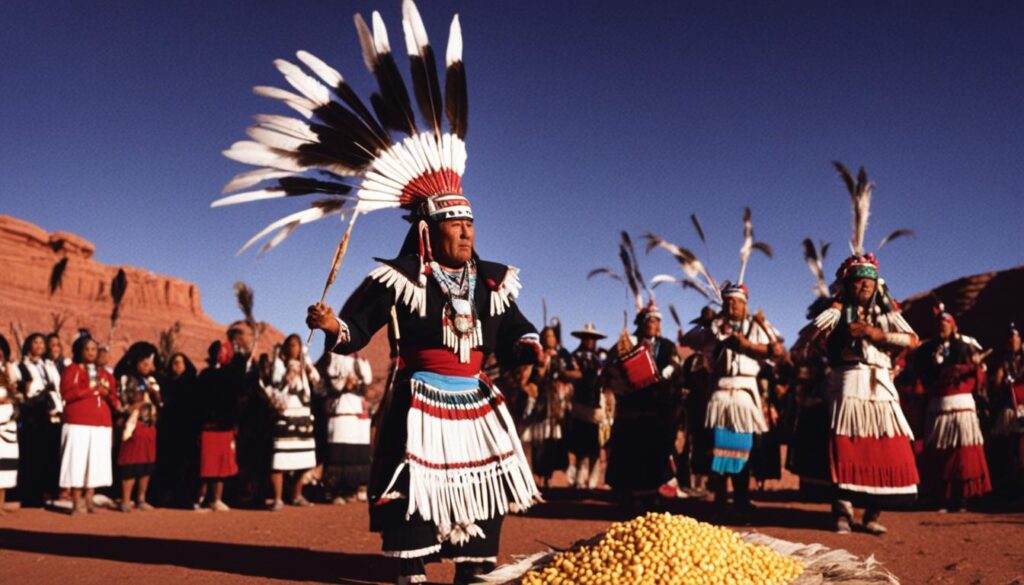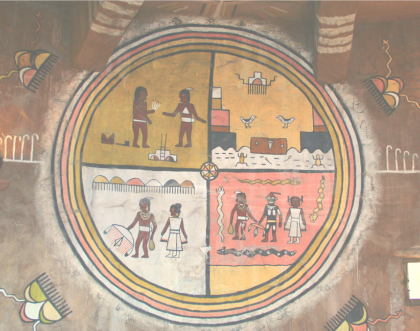
The Enduring Heartbeat: Unpacking the Profound Spiritual Beliefs of the Hopi People
In the stark, sun-baked landscape of the American Southwest, where the red earth meets an endless sky, lies a civilization that has, for millennia, maintained an unbroken spiritual lineage. The Hopi people, whose ancestral lands are centered on three mesas in northeastern Arizona, are not merely a tribe but a living testament to an ancient wisdom, a profound and intricate spiritual belief system that underpins every aspect of their existence. Unlike many modern religions, Hopi spirituality is not a separate compartment of life but the very fabric from which their culture, governance, agriculture, and daily rhythms are woven.
To understand Hopi spiritual belief is to grasp a worldview deeply rooted in reciprocity, balance, and an intimate connection with the Earth and the cosmos. It is a philosophy of stewardship, responsibility, and the sacredness of all life, passed down through an unbroken oral tradition spanning countless generations.

The Land as Sacred Text: Origin and Cycles
At the core of Hopi belief is the understanding of their origins and their sacred covenant with the land. Their oral history speaks of multiple worlds, or "ages," from which humanity emerged, each ending in destruction due to human disharmony, leading to a new emergence. The current world is the Fourth World, and the Hopi believe they were guided by Maasaw, the caretaker of this world, to their present homeland. This journey, marked by migrations and trials, cemented their identity and their responsibility to care for this specific land, often referred to as the "center of the universe" for them.
"Our prophecies speak of four previous worlds and our emergence into this, the Fourth World," explains Leigh Kuwanwisiwma, former director of the Hopi Cultural Preservation Office. "We were given a covenant by Maasaw, the owner of this world, to be caretakers of the land, to live in harmony, and to maintain the balance of the universe through our ceremonies."
This deep connection to the land is not merely symbolic; it is practical and spiritual. The mesas, the springs, the cornfields, and the very air are imbued with spiritual significance. Their survival in an arid environment relies entirely on a profound understanding of natural cycles – the sun’s path, the moon’s phases, the subtle shifts in wind and cloud that herald the precious rain. This understanding translates into a cyclical view of time, where events are not linear but part of an eternal return, much like the seasons themselves. Every ceremony, every prayer, every action is aimed at maintaining this delicate balance and ensuring the continuation of life.
The Hopi Way: Harmony, Responsibility, and the "Right Path"
The essence of Hopi spiritual life can be encapsulated in the concept of Hopi Way or Hopi Law – a code of conduct emphasizing humility, cooperation, and living in balance with nature and community. It is a path of peace (Tuuwaqatsi) and right action. Individual behavior is seen as having communal and even cosmic repercussions. Disharmony or selfishness can disrupt the delicate balance and jeopardize the well-being of the entire community and, by extension, the world.
"The Hopi Way is not just a religion; it’s a way of life," a Hopi elder might tell you. "It’s about walking softly on the earth, respecting all living things, and understanding your place in the great design. Every morning, we greet the sun, offer our prayers, and ask for blessings, not just for ourselves, but for all of creation."
This collective responsibility extends to their agricultural practices, especially the cultivation of corn (maize), which is considered a sacred gift and the literal and symbolic lifeblood of the Hopi people. Different colors of corn—blue, white, yellow, red—each hold specific meanings and are central to their diet and ceremonies. The planting, nurturing, and harvesting of corn are themselves acts of spiritual devotion, embodying their partnership with the land and the forces that bring rain and growth.

The Katsinam: Messengers from the Spirit World
Perhaps the most recognized aspect of Hopi spirituality by outsiders are the Katsinam (often anglicized as "Kachinas"). These are not gods, but spirit beings who represent various aspects of the natural world, ancestors, and specific qualities. They are intermediaries between the human world and the spiritual realm, bringing blessings, rain, guidance, and sometimes discipline.
During elaborate ceremonial dances held in the plazas of the villages, masked Hopi men embody the Katsinam. These dances, often accompanied by hypnotic drumming and chanting, are not performances but profound spiritual events. The dancers are believed to temporarily become the Katsinam, bringing their essence and power to the community. Children are introduced to the Katsinam through dolls carved from cottonwood root, which serve as teaching tools and representations of these benevolent spirits.
There are hundreds of distinct Katsinam, each with its own specific appearance, song, dance, and purpose. The Hemis Kachina, with its towering headdress, symbolizes growth and the harvest, particularly during the Niman or Home-Going Ceremony in July, when the Katsinam are believed to return to their spiritual homes. The Cloud Kachinas bring rain, the Crow Mother symbolizes nurturing, and the Ogre Kachinas serve as disciplinary figures, reminding children of proper behavior. The presence of the Katsinam reinforces the interconnectedness of the Hopi with the spiritual world and the forces that sustain life.
Sacred Spaces and Ceremonial Cycles
Hopi spiritual life revolves around a complex calendar of ceremonies, most of which take place within the kivas – subterranean ceremonial chambers accessed by a ladder through a hole in the roof. These kivas are sacred spaces, representing the Sipapu, the hole through which the Hopi emerged from the previous world. Within their intimate confines, prayers, chants, and rituals are conducted, often in secret, to ensure the health of the community, the success of crops, and the balance of the world.
The ceremonial cycle begins in winter with the Soyal ceremony, marking the winter solstice and initiating the new year. This is a time of purification, prayer for new life, and the turning of the sun. The cycle continues through spring and summer with planting ceremonies, rain dances involving the Katsinam, and culminating in the Niman ceremony. Fall brings the Wuwuchim ceremony, initiating young men into the sacred societies and adult responsibilities. These ceremonies are deeply personal and communal, often lasting for days, involving fasting, prayer, and intricate ritual.
It is crucial to note that many aspects of Hopi ceremonies are private and not for public consumption. This privacy stems from the sacred nature of the rituals and a deep respect for their spiritual efficacy. The Hopi believe that revealing certain aspects to those who do not understand or respect them can diminish their power and even cause harm.
Prophecy and the Future of Humanity
A significant component of Hopi spiritual belief involves a rich tradition of prophecy. These prophecies speak of a series of signs and events that will unfold as humanity progresses, warning of a potential "Day of Purification" if mankind deviates too far from the path of harmony and respect for creation. The most widely known of these is the prophecy of the Blue Star Kachina, which is said to herald a time of profound change and the turning point for humanity.
Hopi elders, like the late Thomas Banyacya, traveled the world, even speaking before the United Nations, to share these prophecies, not as threats, but as urgent warnings and invitations for humanity to choose a path of peace and spiritual awakening. They speak of a time when "spiderwebs" (highways and communication networks) will crisscross the land, when a "gourd of ashes" (the atomic bomb) will be dropped, and when the world will face a choice: to return to spiritual principles or face further destruction.
"We have been entrusted with prophecies that describe the path of humanity, and the need for purification," Thomas Banyacya stated at the United Nations in 1992. "We have seen many of these prophecies come true, and we are now at a critical point. The choice is ours: to return to the spiritual path, or continue down the path of destruction."
This prophetic tradition places a heavy burden of responsibility on the Hopi, who see themselves as guardians of ancient wisdom and crucial contributors to the spiritual well-being of the entire planet.
Resilience in a Changing World
In the face of immense external pressures – from resource extraction (coal mining on Black Mesa), cultural appropriation, and the pervasive influence of modern society – the Hopi people have maintained remarkable spiritual resilience. They continue to practice their ceremonies, speak their language, and teach their children the profound meaning of the Hopi Way.
Their spiritual beliefs are not static relics of the past but a dynamic, living tradition that adapts while preserving its core truths. The challenges they face only serve to underscore the enduring strength of their faith and their unwavering commitment to their ancient covenant.
The Hopi spiritual belief system offers profound lessons for the modern world: the imperative of living in harmony with nature, the power of community, the wisdom of humility, and the critical importance of responsible stewardship of our planet. It is a quiet, powerful heartbeat in the desert, reminding us that true wealth lies not in material gain, but in the sacred interconnectedness of all life and the enduring pursuit of balance. As the sun rises over the ancient mesas each day, the Hopi continue their prayers, carrying the weight of the world’s spiritual balance on their steadfast shoulders.


